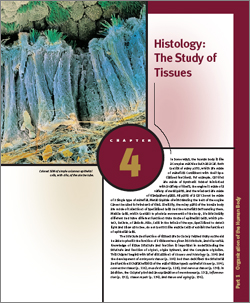
 | In some ways, the human body is like a complexmachine such as a car. Both consist of many parts, which are made of materials consistent with their specialized functions. For example, car tires are made of synthetic rubber reinforced with a variety of fibers, the engine ismade of a variety of metal parts, and the windows are made of transparent glass. All parts of a car cannot be made of a single type ofmaterial. Metal capable of withstanding the heat of the engine cannot be used for windows or tires. Similarly, the many parts of the human body are made of collections of specialized cells and the materials surrounding them. Muscle cells, which contract to produce movements of the body, are structurally different and have different functions than those of epithelial cells, which protect, secrete, or absorb. Also, cells in the retina of the eye, specialized to detect light and allow us to see, do not contract like muscle cells or exhibit the functions of epithelial cells. The structure and function of tissues are so closely related that you should be able to predict the function of a tissue when given its structure, and vice versa. Knowledge of tissue structure and function is important in understanding the structure and function of organs, organ systems, and the complete organism. This chapter begins with brief discussions of tissues and histology (p. 104) and the development of embryonic tissue (p. 104) and then describes the structural and functional characteristics of the major tissue types: epithelial tissue (p. 104), connective tissue (p. 116), muscle tissue (p. 128), and nervous tissue (p. 130). In addition, the chapter provides an explanation of membranes (p. 132), inflammation (p. 132), tissue repair (p. 134), and tissue and aging (p. 136). |